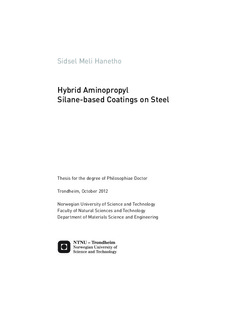| dc.contributor.author | Hanetho, Sidsel Meli | nb_NO |
| dc.date.accessioned | 2014-12-19T13:26:48Z | |
| dc.date.available | 2014-12-19T13:26:48Z | |
| dc.date.created | 2012-11-21 | nb_NO |
| dc.date.issued | 2012 | nb_NO |
| dc.identifier | 571134 | nb_NO |
| dc.identifier.isbn | 978-82-471-3865-6 (printed ver.) | nb_NO |
| dc.identifier.isbn | 978-82-471-3866-3 (electronic ver.) | nb_NO |
| dc.identifier.uri | http://hdl.handle.net/11250/249165 | |
| dc.description.abstract | Thin coatings applied to metals is a material-saving process to improve the surface properties such as abrasion and corrosion resistance of the substrate. Pure inorganic coatings are generally too thin to offer long-term protection, and thick coatings are prone to crack formation during processing. However, by incorporating an organic moiety, thicker and more flexible coatings can be developed. Hence sols and coatings based on 3-(aminopropyl)triethoxysilane, γ-APS, have been synthesized as part of the PhD work.
Initially, pure inorganic alkoxide-based silica coatings were fabricated. These coatings displayed poor abrasion resistance and were poor alternatives with respect to corrosion protection of carbon steel. The need for thicker coatings was thus proposed, and hybrid inorganic-organic coatings were suggested as a probable solution. Thus in Paper I, hybrid inorganicorganic γ-APS-based sols were synthesized and characterized. Molar ratios of water (or solvent) and silane ratios and sol hydrolysis pH were varied. 29Si NMR was used to study the hydrolysis and condensation reactions. The kinetic mechanisms of the hydrolysis and condensation of the sols showed a difference in the structures formed depending on the water/silane ratio and the sol pH. Increasing the water/silane ratio promoted a faster condensation reaction as evidenced by the early evolution of more condensed species. Reducing the sol pH enabled the condensation reaction to slow down thus fascilitating a more complete hydrolysis reaction. Furthermore, hypostoichiometric sols were shown to consist of linear structures while stoichiometric and hyperstoichiometric sols were more cross-linked as evidenced by the higher viscosity and the combination of T2 and T3 species detected by 29Si NMR.
In Paper II, coatings were fabricated from the sols described in Paper I. Transparent and homogeneous hybrid aminopropyl silane-based coatings on steel were prepared by the sol-gel method using the hydrolyzed γ-APS sols as precursors. The coatings were fabricated by dip coating, and the effect of pH, water/silane ratio and solvent/silane ratio during the coating process was investigated with respect to thermal stability, coating thickness, roughness, porosity, contact angle and abrasion resistance. The thickness of the coatings varied between 0.17 and 4.1 μm and was controlled by the preparation conditions of the sol as well as the viscosity of the sols. The coatings were in general smooth and the roughness in the order of a few nanometers. The contact angles with water of the coatings varied from 60 to 80° Organic pentadecane was shown to wet the coatings, which suggested that the coatings also displayed hydrophobic properties. The abrasion resistance improved with decreasing pH of the water used during hydrolysis of the silane. The coatings were characterized with respect to delamination and smearing. Thicker coatings were delaminated while thinner coatings were smeared and displayed lubricating properties. Gels of the hybrid aminopropyl silane-based sols were thermally stable up to 350°C, and the gels displayed a low pore volume and a low surface area.
In Paper III, hybrid aminopropyl silane-based sols with a variation in the molar ratios of water and silane, the molar ratios of solvent and silane and pH, were applied as a bond coat to carbon steel substrates. Fracture strength, abrasion resistance and electrochemical polarization studies have been conducted on these bond coats. Furthermore, the bond coats were applied a top coat consisting of a polyaspartic paint, and the combination coatings were subsequently exposed to an ageing resistance test for 5 weeks. The bond coat-top coat combination coatings were demonstrated to significantly improve the corrosion protection behavior of carbon steel. The thickness of the bond coats varied from 0.35 to 4.1 μm, while the bond coat-top coat combination coatings were all in the range of 100 μm. | nb_NO |
| dc.language | eng | nb_NO |
| dc.publisher | Norges teknisk-naturvitenskapelige universitet, Fakultet for naturvitenskap og teknologi, Institutt for materialteknologi | nb_NO |
| dc.relation.ispartofseries | Doktoravhandlinger ved NTNU, 1503-8181; 2012:276 | nb_NO |
| dc.relation.haspart | Hanetho, Sidsel Meli; Bouzga, Aud M.; Kausc, Ingeborg; Simon, Christian; Grande, Tor; Einarsrud, Mari-Ann. Structural Characterization of Hybrid Aminopropyl Silane-based Sols. . | nb_NO |
| dc.relation.haspart | Hanetho, Sidsel Meli; Kaus, Ingeborg; Simon, Christian; Grande, Tor; Einarsrud, Mari-Ann. Synthesis and Characterization of Hybrid Aminopropyl Silane-based Coatings on Stainless Steel Substrates. . | nb_NO |
| dc.relation.haspart | Hanetho, Sidsel Meli; Owea, Lars-Erik; Knudsen, Ole Øystein; Kaus, Ingeborg; Simon, Christian; Grande, Tor; Einarsrud, Mari-Ann. Corrosion Protective Aminopropyl Silane-based Coatings on Carbon Steel. . | nb_NO |
| dc.relation.haspart | Johnsen, Sverre Gullikstad; Hanetho, Sidsel Meli; Tetlie, Pål; Johansen, Stein Tore; Einarsrud, Mari-Ann; Kaus, Ingeborg; Simon, Christian Rone. Paraffin wax deposition studies on coated and non-coated steel surfaces. Proceedings of International Conference on Heat Exchanger Fouling and Cleaning IX - 2011, 2011. | nb_NO |
| dc.title | Hybrid Aminopropyl Silane-based Coatings on Steel | nb_NO |
| dc.type | Doctoral thesis | nb_NO |
| dc.contributor.department | Norges teknisk-naturvitenskapelige universitet, Fakultet for naturvitenskap og teknologi, Institutt for materialteknologi | nb_NO |
| dc.description.degree | PhD i materialteknologi | nb_NO |
| dc.description.degree | PhD in Materials Science and Engineering | en_GB |

